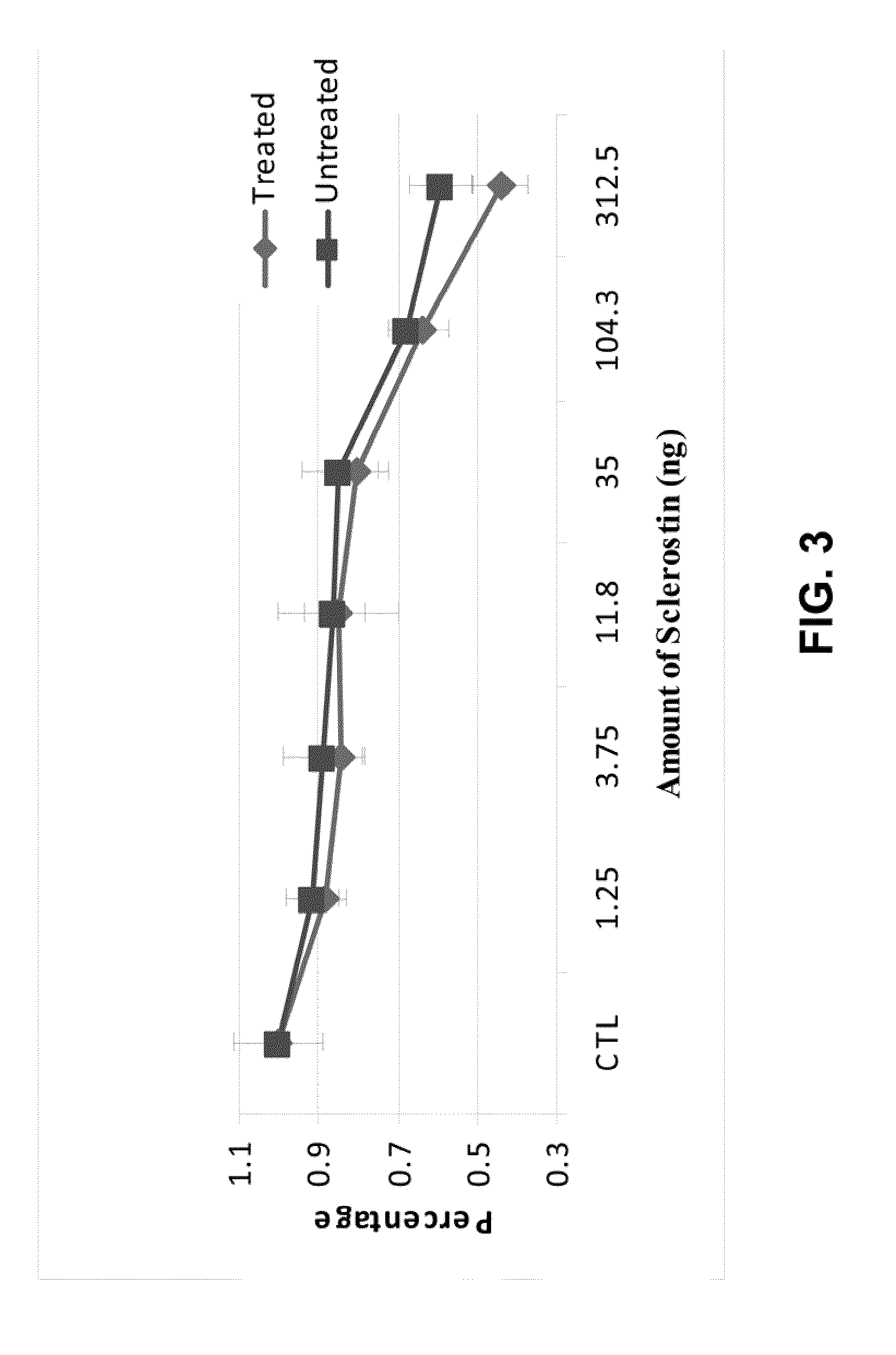Sulfation of wnt pathway proteins
a sulfation and pathway technology, applied in the field of immunotherapy, can solve the problems of affecting the activity level of the target protein, affecting the clinical outcome,
- Summary
- Abstract
- Description
- Claims
- Application Information
AI Technical Summary
Benefits of technology
Problems solved by technology
Method used
Image
Examples
example 1
In Vitro Sulfation of Sclerostin
Human Sclerostin (25 μg R&D Systems, Minneapolis, Minn.)) was reconstituted in 100 μl of 100 mM MES pH=7.0. Sulfation was carried out by mixing 50 μl (12.5 μg) human Sclerostin and 22.5 μl (10.0 μg) of human TPST1 (R&D Systems) with 125 μl of assay mix [78.87 mM MES pH 7.0, 2.5 mM MgCl2, 2.5 mM MnCl2 1.25 mM CaCl2 and 200 μM PAPS (Sigma)]. Incubation was carried out for 1.5 hrs at 37° C. Buffer was then exchanged into 10 mM Tris pH 7.5 using protein desalting spin columns (Pierce Biochemicals, Rockford, Ill.).
example 2
Detection of Sulfation Modifications by MS Analysis
Peptides from the Sclerostin from Example 1 as well as untreated Sclerostin were digested with either trypsin or GluC and loaded onto a C18 column followed by injection into a LTQ mass spectrometer. In the first analysis, the mass spectrometer was instructed to make MS / MS of all eluting peptides. The resulting data was analyzed and three peptides from Sclerostin containing tyrosines were identified: LGEYPEPPPELE, YVTDGPCR and ANQAELENAY. In the second analysis, targeted analysis was performed where the mass spectrometer was instructed to only do MS / MS on masses corresponding to the putative sulfated tyrosine containing peptides. For the GluC sample, the mass spectrometer was set to perform MS / MS at m / z 725.6, the mass of the doubly charged peptide LGEYPEPPPELE plus sulfation, at a normalized collision energy for CID at 2%, 4% or 10% and an MS3 of the highest fragment in each of the three MS / MS. In the tryptic sample, MS / MS was perfo...
example 3
Biological Effects of In Vitro Sulfation of Sclerostin
A) Effects of Sulfation on Binding of Sclerostin to LRP5
1) Preparation of Alkaline Phosphatase-Labeled LRP5 (AlkPhos-LRP5)
293T cells were seeded into 9 cm dishes. The next day, each dish was transfected with 12 of LRP5R1 / 2AP construct using Lipofactamine Plus (Invitrogen, Carlsbad, Calif.) according to the manufacturer's instructions. LRP5R1 / 2-AP is a nucleic acid construct that expresses LRP5 extracellular domains 1 and 2 fused to alkaline phosphatase. 48 hours after transfection, the supernatant of the culture was collected as LRP5R1 / 2AP conditioned medium and concentrated 20 times using a Centricon unit (Millipore, Billerica, Mass.) and stored at −80° C.
2) Binding of AlkPhos-LRP5 to Sclerostin
Various amounts of unmodified Sclerostin or the in vitro treated Sclerostin from Example 1 were diluted into 80 μl of TBST buffer and added to individual wells of 96 well plates. After overnight incubation, unbound proteins were removed a...
PUM
 Login to View More
Login to View More Abstract
Description
Claims
Application Information
 Login to View More
Login to View More - R&D
- Intellectual Property
- Life Sciences
- Materials
- Tech Scout
- Unparalleled Data Quality
- Higher Quality Content
- 60% Fewer Hallucinations
Browse by: Latest US Patents, China's latest patents, Technical Efficacy Thesaurus, Application Domain, Technology Topic, Popular Technical Reports.
© 2025 PatSnap. All rights reserved.Legal|Privacy policy|Modern Slavery Act Transparency Statement|Sitemap|About US| Contact US: help@patsnap.com



